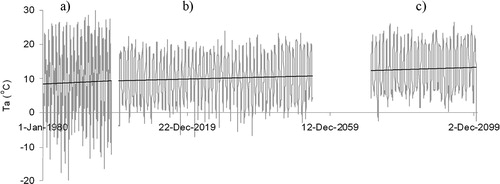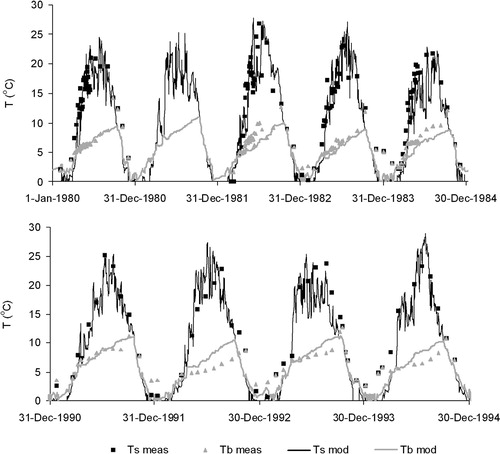ABSTRACT
Among the numerous processes that govern the functioning of a lake ecosystem, the regime of dissolved oxygen (DO) is of primary importance. The DO content is strongly affected by the temperature regime, mixing conditions and by the duration of the ice-covered period. These are formed due to atmospheric forcing and are, therefore, subject to variations in regional climate. Despite the large amount of data revealing the physical effect on the biological and chemical regimes in lakes, there is still insufficient understanding, both qualitative and quantitative, of how a lake ecosystem would be affected by changes in the lake temperature and mixing conditions due to changes in the atmospheric forcing. Below, the study of shallow lakes’ response to climatic changes using the coupled FLake–FLakeEco modelling system is presented. The results obtained reveal the extreme vulnerability of the lakes’ ecosystems to changes in atmospheric forcing. In ‘future’ climate the permanent existence of potentially dangerous anaerobic zones in shallow lakes is expected. The projected decreased oxygen concentrations are caused by: (1) the reduced oxygen flux from the atmosphere to the lakes due to increased temperature; and (2) strengthened density stratification of the water columns which would prevent aeration of the near-bottom layers.
1. Introduction
The water quality in freshwater reservoirs is in many respects determined by the content of dissolved oxygen (DO). The evolution of the oxygen regime in lakes is usually controlled by the following processes: (1) gas exchange through the water–air interface; (2) vertical turbulent mixing within a water column; (3) photosynthesis that contributes to the increase of DO concentration in water; (4) respiration of water organisms, bacterial oxidation of organic matter, chemical oxidation of H2S, Fe2 + and other reduced inorganic substances leading to a decrease of the DO content in water; and (5) oxygen uptake by bottom sediments.
In lakes with high DO concentration, the bacterial destruction of organic matter is accompanied by extraction of carbon dioxide, which is harmless for hydrocoles, into the water. A decrease of the DO concentration or its complete absence leads to the activation of anaerobic processes, which usually occur with evolving of such deoxidised gases as methane (CH4), hydrogen sulphide (H2S) and ammonia (NH3). Those are capable not only of worsening the water quality, but also of being toxic (especially concerning H2S) (Szabó, Citation2007).
Generally speaking, DO depletion is a phenomenon that occurs in aquatic environments as DO becomes reduced in concentration to a value detrimental for aquatic organisms living in the system. The onset and continuous existence of the DO depletion may provoke formation of an anaerobic ‘dead zone’ and lead to such negative consequences as fish kill, loss of benthic organisms, and changes in the trophic chains of water ecosystems (Odum, Citation2004).
DO depletion in shallow lakes occurs in the absence of water aeration. The formation of anaerobic zones in lakes may take place during the open water period as well as in winter. In the former case, one of the main reasons for the DO depletion is the presence of a so-called ‘thermocline’ in a lake. Being a layer where the water density increases, the thermocline separates upper well-aerated water layers from the near-bottom ones, where the DO consumption prevails over the inflow of oxygen from the upper layers. Resulting from the peculiarities of the lake, i.e. atmosphere–water interactions, features of the lake's trough and specific water clarity, the magnitude of the water density jump through the thermocline could be considerably different. In the case of a significant density gradient, the thermocline is capable of isolating a near-bottom zone for a long time and thereby provoking the development of deep DO depletion up to the formation of an anaerobic zone. Vice versa, a weak thermocline allows the penetration of wind mixing in the water column from top to bottom providing aeration of the bottom layers.
In winter the most dramatic situation may occur in ice-covered lakes located in moderate and high latitudes because the factors defining a DO regime in a shallow ice-covered lake essentially differ from those during the open water period. First, it is related to main sources of oxygen flow. In winter, the ice-cover excludes gas exchange with the atmosphere. In addition, the amount of solar radiation penetrating into the water becomes negligible, which leads to a drastic decrease of photosynthetic intensity. Thus, main sources of oxygen supply practically disappear, and only consumption of oxygen by bacterial plankton in the process of organic matter decomposition together with its absorption by bottom sediments control the DO content in a lake (Hargrave, Citation1972). The DO uptake due to biochemical destruction of organic matter in water and in sediments may lead to oxygen deficit there, on occasion to its complete depletion and the eventual development of fish-kill effect (Greenbank, Citation1945; Hutchinson, Citation1957; Hargrave, Citation1972; Barica and Matias, Citation1979). As the ice-covered period in boreal lakes lasts for 180–190 d, this, in turn, may endanger the whole lake ecosystem.
Because of negative consequences of DO depletion in lakes, the development of forecasting methods is of vital importance. Recently, numerous efforts were undertaken to study the lake response to changes in global and regional climate. The main lake processes were considered from the viewpoint of their sensitivity to atmospheric forcing, that is, biochemical processes (Anneville et al., Citation2003 Citation2004; Carvalho and Kirika, Citation2003; Hargeby et al., Citation2004; George and Hurley, Citation2004; Salmaso, Citation2005), thermal regime, mixing conditions in lakes (Gerten and Adrian, Citation2001; Scheffer et al., Citation2003), and the dynamics of separate chemical elements (Vesely et al., Citation2003). As a rule, those are related to one or two of the most commonly used indices of atmospheric activity – North Atlantic Oscillation index (NAO) and El Niño Southern Oscillation index. It should be noted that the existing practice for revealing the inter-relations between lake processes and mentioned indices is based on statistical appropriateness, but not on knowledge of the atmospheric forcing effect on specific processes and on a lake ecosystem in the whole. Statistical relationships quite often lead to superficial knowledge in the understanding of natural processes (Håkanson, Citation2004). To avoid extremes of a one-sided approach to the solution of the above-mentioned problem, another way to study the response of lakes to climate change is suggested, i.e. studying the physically grounded links in the atmosphere – lake physics – lake biochemistry system. The main objective of this study is to take a step forward along this line and to evaluate the climate change impact on oxygen regime of shallow lakes. The focus of the proposed effort is on the oxygen regime in small-to-medium size lakes located in Central Europe. Due to small thermal inertia, such lakes should experience considerable changes in their temperature and mixing regime due to variations in atmospheric forcing. These changes in the lake physics may strongly affect lake chemistry and biology, above all, in the DO regime, making ecosystems of small-to-medium size lakes potentially vulnerable. Descriptions of the sites of the study, observational lake data, meteorological information and climatic scenarios as well as a brief description of the models used are given in Section 2 of the paper. Results of the verifications of hydrothermodynamic and oxygen models are presented in Section 3. The most significant results of long-term projections of lakes’ response to possible climatic variations are discussed in the Section 4. Section 5 contains the main conclusions of the study.
2. Sites of the study, materials and methods
2.1. The lakes
Two shallow German lakes – Müggelsee and Heiligensee (hereinafter MS and HS, respectively) – located in Berlin have been chosen as the subjects of investigation. The trophic status of the lakes can be characterised as eutrophic, i.e. the lakes’ waters contain a large amount of dissolved and suspended organic matter. Bacterial decay of this organic matter requires a large amount of DO, so the DO depletion in bottom layers should be intrinsic for both lakes a priori. Due to their proximity (30 km), it can be supposed they are subject to the more or less similar atmospheric forcing. Both lakes have similar bottom topography. MS is a shallow lake located in the south-eastern part of the city, with mean/maximum depth of 4.5/8.0 m and a lake area of 7.3 km2. The lake is mixed down to the bottom many times throughout the year with occasional vertical stratification periods in summer and winter. HS is a shallow lake located in the northern part of Berlin, with mean/maximum depth of 5.9/8.1 m and a lake area of 0.9 km2. In contrast to MS, HS is mixed down to the bottom only in spring and in autumn when strong convective mixing takes place in water bodies. The lower part of the water column remains stratified during the whole summer. The dissimilarity in mixing conditions could be explained by the different wind fetch in the two lakes, but this difference is not great enough to produce reasonably large distinctions in temperature profiles. A more probable explanation lies in the difference in water clarity of the lakes considered (see Section 3). The water transparency in HS is two times lower. As a result, the solar radiation incoming onto the lake surface in the summer penetrates to a lesser depth of the water column. This leads to intensive warming of the near-surface layer, while the near-bottom zone remains cold, and the strong density stratification generated prevents full water column mixing. In recent years, ice-cover periods are rather rare events in both lakes considered here.
2.2. Observational data
The thermal and DO regimes have been studied fairly well in both lakes. Regular complex observations have been conducted in MS since 1978 and in HS since 1975. The observational data used in this study represent vertical distributions of the water temperature and DO concentrations measured weekly at a single sampling site. As follows from the analysis of data available, DO depletion routinely occurs in both lakes. However, the duration of the depletion periods differ drastically. In MS they are occasional and short, while in HS DO depletion may last for several months and provokes the appearance and further development of an anaerobic zone of significant thickness (up to 3–4 m). The formation/collapse of DO depletion coincides with absence/presence of mixing events in the lakes. In other words, the phenomenon under study is to a great extent controlled by mixing, which results from the lake-atmosphere interaction, and should be sensitive to the changes in atmospheric forcing.
2.3. The models
To solve the problem, in the present study the FLake–FlakeEco modelling system was applied. The detailed description of the models is respectively given in Golosov et al. (Citation2007), Mironov (2008) and Mironov (Citation2010). FLake is based on a self-similar parametric representation (assumed shape) of the evolving vertical profiles of prognostic variables and incorporates a flexible parameterisation of the evolving temperature profile in the thermocline. This involves an advanced formulation to compute the mixed-layer depth, including the equation of convective entrainment and a relaxation-type equation for the depth of a wind-mixed layer, a module to describe the vertical temperature structure of the thermally active layer of bottom sediments, the interaction of the water column with bottom sediments, and an advanced snow–ice module. The ability of the model to predict the temperature structure in lakes of various depths on diurnal to seasonal time scales was successfully tested against observational data through single-column numerical experiments (e.g. Balsamo et al., Citation2010). To reveal the peculiarities of the lake's DO regime under physical impact caused by atmospheric forcing, the model FLakeEco (Kondratiev et al., Citation1998; Golosov and Ignatieva, Citation1999; Golosov et al., Citation2007) was used. The conceptual scheme of the FLakeEco oxygen module is presented in a and b.
Fig. 1. Main processes affecting the DO regime that are taken into account in the FLakeEco model: (a) the case of open water; and (b) the case of ice-covered lake. Arrows mark the directions of DO fluxes in the model.
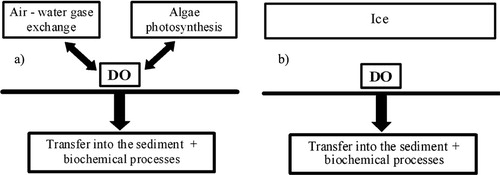
FLakeEco is a low-order parameterised model capable of simulating the annual cycle of DO regime of a small-to-medium size lake. The key physical parameters, namely water temperature and mixing conditions for the FLakeEco can be taken from the FLake model numerical runs. It should be particularly mentioned that FLakeEco is based on the same principle as FLake. This allows the description of salient features of both the lake physics and the lake DO regime, using one and the same basic concept.
Thus, by analogy to the FLake model, a forth-order polynomial with variable coefficients is applied to describe the vertical distribution of DO concentration. The polynomial coefficients, being dependent on oxygen flux at the water–sediments interface, provide the representation of all possible types (shapes) of vertical DO profiles in the model. The double-pointed arrow (a) in the case of the air–water gas exchange means that the lake absorbs oxygen from the atmosphere if the difference between the concentration of DO in the water and the so-called ‘concentration of saturation’ – the maximal amount of oxygen amount of oxygen that can be dissolved in the water at a given water temperature – is negative. The rate of oxygen transfer across the air–water interface depends on many parameters, such as the density stratification both in the atmospheric surface and immediate upper water layers, wind stress at the water–air interface, and presence of waves (Liss and Slinn, Citation1983). The FlakeEco model takes into account above-mentioned processes at the simulation of gas exchange between lake water and atmosphere. The similar arrow in the case of algae photosynthesis means that the latter plays two opposite roles in oxygen budget in lakes. Phytoplankton emits the gas during the organic matter production, and consumes it through self-respiration. The algae photosynthesis is parameterised in the FLakeEco according to the Calvin–Benson cycle (Seki, Citation1982). The rate of algae respiration is an empirical parameter of the model. Downward arrows in a and b specify that the major amount of DO is absorbed by sediments and consumed by bacteria through the organic matter decay in the near-bottom vicinity. Absence of arrows indicating the sources of oxygen in the ice-covered case (b) means that the lake is completely isolated from the atmosphere and gas exchange does not take place. Moreover, the intensity of solar radiation is too small under ice-cover and photosynthesis is suppressed.
2.4. Meteorological information and climatic scenarios
To perform numerical simulations with the FLake and FLakeEco models, three different sources of meteorological information were used. Firstly, to verify the models against the observational data, the sets on seven external input meteorological parameters, i.e. incoming short-wave solar radiation, wind speed, cloudiness, absolute humidity, air temperature, air pressure and precipitation were used. Meteorological observations have been conducted in the Berlin area by the German Meteorological Service (DWD), and were kindly provided by colleagues from The Leibniz-Institute of Freshwater Ecology and Inland Fisheries (IGB) to perform the present study. The data cover the period 1980–1998. To evaluate the lakes’ response to possible climatic changes, two different scenarios, i.e. GLOWA and MPI B2 have been used.
The former, which has been developed at the Potsdam Institute of Climate Research (PIK) for the Elbe River area, was used to predict the atmospheric forcing on the lake in the near future (Jacob and Gerstengarbe, Citation2005). The scenario, which provides daily values of the main meteorological characteristics for the period of 2005–2055, was achieved by the method of regional statistical downscaling, which uses mean climatic trends that are based on the global atmosphere-ocean circulation model (GCM) ECHAM4/OPYC3 (Roeckner et al., Citation1999) and the International Panel on Climate Change (IPCC) greenhouse emission scenarios (Watson, Citation2001).
The regional climate scenario for the period of 2071–2100 is adopted from the PRUDENCE data archive (http://prudence.dmi.dk/, site accessed on 01 June 2009). The MPI B2 scenario was chosen (Räisänen et al., Citation2004), based on the ECHAM4/OPYC3 global circulation model with the IPCC SRES B2 emission scenario (Nakićenović and Swart, Citation2000; Watson, Citation2001), which corresponds to moderate emission of greenhouse gases in the future. The common feature of both scenarios reproducing the future situation is the condition ‘if the current warming tendency persists’ (Kirillin, Citation2010). The time series of air temperature from all three data sets are shown in a–c.
3. Empirical verification of the Flake–FLakeEco modelling system
The observational data collected in both lakes as well as data from U.S. National Centers for Environmental Predictions (NCEP) reanalysis on atmospheric meteorological forcing were used to verify the models. The verification consisted of the following procedure. Initially the models simulated thermal and DO regimes with a daily time step for the period 1980–1998. All empirical parameters of both models remained invariable for the whole period of calculations. Then the observed data on the water surface and near-bottom temperatures, surface and near-bottom DO concentrations as well as the data on the thickness of the anaerobic zone were compared with the calculated values for the corresponding periods.
represents the measured and calculated surface and near-bottom temperature for MS. Results from the calculations show that FLake describes the temporal variability of both temperatures for the whole period of observations fairly well, both qualitatively and quantitatively. All above-mentioned features of the thermal regime of MS, i.e. frequent mixing from top to bottom and, consequently, high values of the near-bottom water temperature in summer, are reflected in the modelling results.
Fig. 3. Temporal dynamics of surface and near-bottom temperature in MS. Points stand for observational data (Ts meas and Tb meas), lines represent results of simulations (Ts mod and Tb mod).
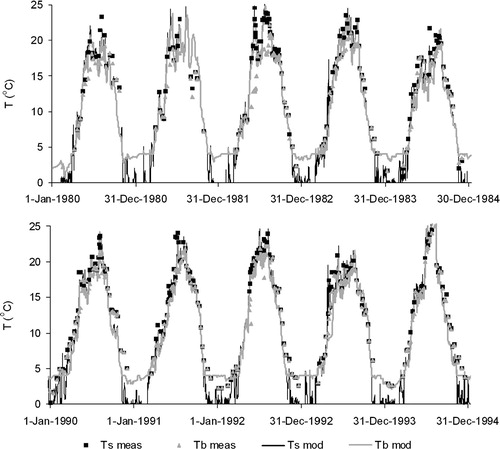
The analogous results of the FLake verification for HS are presented in . It should be admitted that the model reproduces the absolute values of the HS near-bottom temperature somewhat less accurately than in the MS case. From the standpoint of the DO regime this drawback is quite excusable as in the process of appearance and further development of the DO depletion, the main role belongs to the mixing events that control the formation and duration of an un-aerated period. These events are reproduced by FLake correctly.
Keeping in mind the dissimilarity in mixing conditions in the lakes considered, some comments on the reasons of this phenomenon should be added here. During the verifications of the FLake model, numerical experiments were performed to compare the extent of influence of the extinction coefficient and the wind fetch on mixing. Initially, the model runs were conducted for both lakes with water clarity typical for MS, whereas the wind fetch varied in wide range (from 103 to 104 m). Results of simulations demonstrated that both lakes should be polymictic in such a case. More or less long periods of stable stratification during the open water period were not revealed. Then the model runs were performed with the clarity typical for HS (two times less). The wind fetch varied in the same way as in the first series of simulations. According to the second model runs, both lakes should turn into a dimictic regime. Analysis of the simulation findings allows one to conclude that water clarity prevails over the wind fetch in formation of the vertical density structure in small lakes (at least in our case).
Results of verification of the FLakeEco model are presented in a and b, 6a and b and 7. As was mentioned above, the upper layers of lakes are, as a rule, well aerated and DO concentration there is rather high, whereas in the near-bottom layers the DO depletion represents real environmental danger. Therefore it is essential that the model accurately reproduces the DO regime in the near-bottom part of a water column. represents temporal dynamics of the measured and calculated surface and near-bottom DO concentrations in MS during two 5-yr verification periods. As mentioned in Section 2.1, the lake is polymictic, i.e. it is mixed down to the bottom many times during the course of a year with occasional vertical stratification periods in summer and winter. As it follows from the results presented, despite the permanent mixing, the DO concentrations decrease to rather low values during short spans of stable stratification, but always above zero. It shows that the rates of DO consumption are very high in the lake, but mixing compensates this loss of DO.
Fig. 5. Temporal dynamics of surface and near-bottom DO concentrations in MS during 1980–1984 (a); and 1990–1994 (b). Points stand for the observational data (Cs meas and Cb meas), line represents the results of simulations (Cs mod and Cb mod).
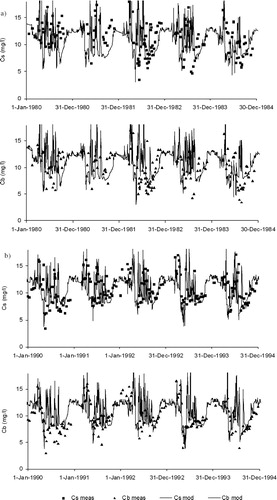
The verification results for HS are presented in . Here the second period of verification is shifted by 5 yr because there were no oxygen observations in HS during 1992–1994. The difference between the lakes is obvious. In the HS case, inability of the mixing processes to reach the near-bottom zone causes the existence of DO depletion there over the long period of time (up to several months). The duration of this period is enough for complete consumption of DO in the vicinity of sediments that provokes the development of an anaerobic zone.
Fig. 6. Temporal dynamics of surface and near-bottom DO concentrations in HS during 1980–1984 (a); and 1994–1998 (b). Notation is the same as in Fig. 5.
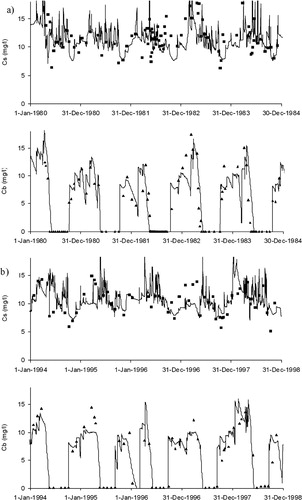
Results of the verification of the FLakeEco model in respect to the thickness of the anaerobic zone are shown in . As one can see, the thickness of the anaerobic zone in HS increases up to 3–4 m according to the observational data and results of the model calculations. Moreover, the start/end dates of the phenomenon from observations and numerical simulations nearly coincide. Thus, the model predicts the formation and collapse of the anaerobic conditions in the lake fairly well.
Fig. 7. Evolution of an anaerobic zone in HS. Points stand for observational data, line represents the results of simulations.
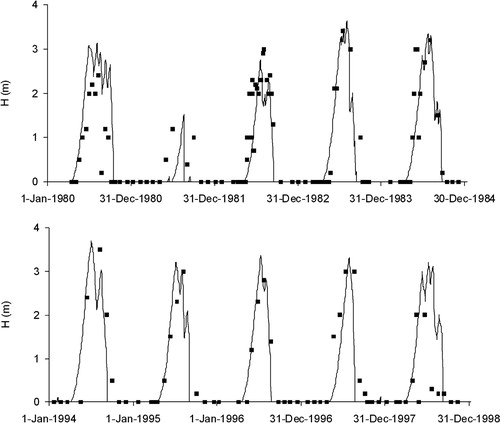
As follows from , the growth rate of the anaerobic zone is very high and if it were not for the intensive aeration of the near-surface layers, the DO depletion could reach the lake surface.
4. Long-term projecting of lakes’ response to possible climatic variations
Upon testing of the FLake and FLakeEco, numerical experiments with the coupled FLake–FLakeEco modelling system were performed in order to analyse the response of the lakes considered to variations in atmospheric forcing on long-term time scales and to identify conditions that favour the development of the oxygen depletion. Atmospheric forcing scenarios used in the present study are briefly described above. Three different numerical runs were performed for each lake. The first experiment was carried out with observational meteorological data and covered the period from 1980 through 1998. The GLOWA Elbe climatic scenario was used as atmospheric forcing in the second experiment, covering the period from 2005 to 2055. And finally, the MPI B2 scenario was applied to describe the climatic conditions at the end of the 21st-century (2071–2100). Results of calculations are shown in and in terms of monthly averaged values of the parameters considered. Averaging was conducted over whole periods of simulations, i.e. from 1980 to 1998, from 2005 to 2055 and from 2071 to 2100.
Fig. 8. Current and projected seasonal dynamics of surface (Ts) and near-bottom (Tb) temperature in MS and in HS.
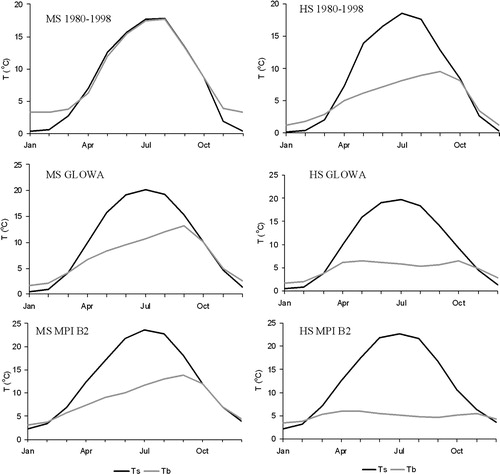
Fig. 9. Current and projected seasonal dynamics of the anaerobic layer thickness in MS (a); and in HS (b). The white area bounds well aerated ‘problem-free’ upper mixed layers, grey coloured area coincides with the gradual decrease (from 100% to 0% of saturation) of DO concentration. The anoxic zone (complete absence of DO) is marked by black colour.
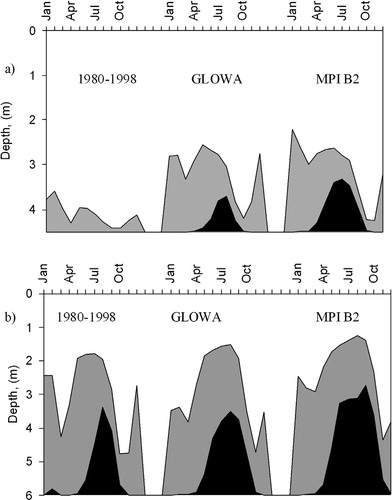
The results of numerical experiments demonstrate drastic changes in the thermal and mixing regime in both lakes (). Being well mixed at present (the surface and near-bottom temperature are practically equal, except in winter), MS may turn into a dimictic water body as early as mid-century. Full mixing events are expected twice a year – in March and in October. The stable period of stratified water column would be about 7–8 months (from March to October) with all the ensuing consequences for the DO regime. The duration of complete DO depletion would coincide with the period of stable stratification of the water column (from March to the beginning of October), and the thickness of the anaerobic zone rises up to one meter above the lake bottom (a). Ice-cover will disappear completely. As long as the absence of an ice-cover allows aeration of the near-bottom layers, the latter projection marks a possible positive change for the lake ecosystem. The mid-century tendencies provoke further worsening of the situation, and MS should become almost monomictic by the end of the century (full mixing occurs once a year, in October). The duration of anaerobic conditions may increase to up to eight months (from February to October), and in this case the ‘dead’ zone thickness over the sediments may reach 1.5–2 m.
In HS ( and b) the events are expected to develop in a similar way but the manifestations of the lake's response to the climatic changes might be much more evident. The DO regime of the lake being not problem-free at present, can therefore only get worse. By the middle of the 21st-century the lake will become strictly monomictic. The DO depletion is expected to exist throughout the whole year. The duration of completely anaerobic conditions in the lower layers of the water column and the thickness of the ‘dead’ zone might be about 9 months and 3.5 m, respectively. This tendency should increase toward the end of the century. The probability of HS transforming into a lifeless water reservoir is quite high.
If events should develop according to the aforementioned projections, serious problems should be expected in both lakes. The most evident consequence is water quality deterioration. The lakes will lose partially or completely their present water consumption, fishery and recreation significance (notice that currently MS is actively used both as a source of drinking water and recreation).
The only extenuating circumstance that may prevent the worsening of the situation is the expected higher air temperatures that would prevent ice formation in winter. Ice-cover being a natural closure between the water body and atmosphere drastically decreases the gas exchange and the algae photosynthesis. Being ice-covered, both lakes would be isolated from the atmosphere additionally for several months which progressively accelerates all negative processes. In absence of the ice-cover, a ‘temporal window’ remains for the winter aeration of the lakes within the seasonal course of DO regime.
5. Conclusions
The results from the study reveal a high sensitivity of the DO regime to the possible changes in atmospheric forcing. In light of the considered forthcoming climatic changes, a large number of negative consequences could be expected not only for the DO regime but for the lakes’ ecosystems as a whole. The oxygen depletion is a trigger that provokes a large amount of reduced substances (H2S, CH4, etc.) delivered to the water column from sediments. The worst possible result would be the decrease of biodiversity in water bodies (Odum, Citation2004). Then, eventually, we may face gradual degradation of the ecosystems of so-called ‘lake regions’ in England, Sweden, Finland, Karelia and the Karelian Isthmus, where lakes represent a considerable part of the environment. To be honest, it should be mentioned that the authors operated with nothing but two climatic scenarios corresponding to the currently prevalent strategy of Global Warming, whereas it is necessary to realise that the trends in climate change might differ. In the more optimistic case, the lakes’ response might not be as dramatic as described in the present study. Secondly, the substantial circumstances capable of softening the projections performed are the drawbacks of the 1-D approach applied in the present study. Basically, 1-D models account for the vertical variability of parameters considered and do not consider advective water exchange between the very shallow littoral (near-shore) zone and the open lake. Being well aerated due to wind mixing, the littoral zones could be considered as an additional source of DO, playing the role of peculiar ‘lungs’ for lakes.
6. Acknowledgements
This study was supported by the Russian Academy of Sciences; the Russian Fund of Basic Research (project 10-05-91331-DFG); and by the German Research Foundation (DFG, Project KI-853/3-1 in frames of the program ‘AQUASHIFT’). Support is gratefully acknowledged.
References
- Anneville O. Ginot V. Druart J.-C. Angeli N. Long-term study (1974–1998) of seasonal changes in the phytoplankton in Lake Geneva: a multi-table approach. J. Plankton Res. 2003; 24: 993–1008.
- Anneville O. Souissi S. Gammeter S. Straile D. Seasonal and inter-annual scales of variability in phytoplankton assemblages: comparison of phytoplankton dynamics in three peri-alpine lakes over a period of 28 years. Freshwat. Biol. 2004; 49(1): 98–115.
- Balsamo, G, Dutra, E, Stepanenko, V. M, Viterbo, P, Miranda, P. M. A and co-authors. 2010. Deriving an effective lake depth from satellite lake surface temperature data: a feasibility study with MODIS data. Boreal Env. Res. 15, 178–190.
- Barica J. Mathias J. A. Oxygen depletion and winterkill risk in small prairie lakes under extended ice cover. J. Fish. Res. Board Can. 1979; 36: 980–986.
- Carvalho L. Kirika A. Changes in shallow lake functioning: response to climate change and nutrient reduction. Hydrobiologia. 2003; 506(1): 789–796.
- George D. Hurley M. The influence of sampling frequency on the detection of long-term change in three lakes in the English Lake District. Aquat. Ecosyst. Health Manage. 2004; 7(1): 1–14.
- Gerten D. Adrian R. Differences in the persistency of the North Atlantic Oscillation signal among lakes. Limnol. Oceanogr. 2001; 46(2): 448–455.
- Golosov S. Ignatieva N. Hydrothermodynamic features of mass exchange across the sediment–water interface in shallow lakes. Hydrobiologia. 1999; 408/409: 153–157.
- Golosov, S, Maher, O, Schipunova, E, Terzhevik, A, Zdorovennova, G and co-authors. 2007. Physical background of the development of oxygen depletion in ice-covered lakes. Oecologia. 151(2), 331–340.
- Greenbank J. Limnological conditions in ice-covered lakes, especially as related to winter-kill of fish. Ecol. Monogr. 1945; 15(4): 343–392.
- Hargeby A. Blindow I. Hansson L.-A. Shifts between clear and turbid states in a shallow lake: multi-causal stress from climate, nutrients and biotic interactions. Arch. Hydrobiol. 2004; 161(4): 433–454.
- Håkanson L. Break-through in predictive modelling opens new possibilities for aquatic ecology and management – a review. Hydrobiologia. 2004; 518(1–3): 135–157.
- Hargrave B. A comparison of sediment oxygen uptake, hypolimnetic oxygen deficit and primary production in Lake Esrom, Denmark. Vehr. Int. Ver. Limnol. 1972; 18: 134–139.
- Hutchinson G. E. A Treatise on Limnology. J. Wiley and Son, Inc.: NY, 1957; I: 1015 p.
- Jacob D. Gerstengarbe F.-W. Klimaszenarien für den deutschen Teil des Elbe-Einzugsgebietes. Integrierte Analyse der Auswirkungen des globalen Wandels auf Wasser, Umwelt und Gesellschaft im Elbegebiet. Wechsung F.Becker A.Gräfe P.Berlin: Weissensee, 2005; 85–118.
- Kirillin G. Modelling the impact of global warming on water temperature and seasonal mixing regimes in small temperate lakes. Boreal Environ. Res. 2010; 15: 279–293.
- Kondratiev S. Golosov S. Kreiman K. Ignatieva N. Modelling hydrological processes and mass transfer in a watershed-lake system. Water Resources (Vodnye Resursy) . 1998; 25: 571–580.
- Liss, P and Slinn, G. 1983. Air–sea exchange of gases and particles. In: Proceeding of the NATO Advanced Study Institute on Air–Sea Exchange on Gases and Particles, University of New Hampshire, USA, 19–30 July 1982. Reidel Publishing Company: DordrechtHolland, pp. 241–289.
- Mironov D. Implementation of the lake parameterization scheme FLake into the numerical weather prediction model COSMO. Boreal Environ. Res. 2010; 15: 218–230.
- Nakićenović, N. and Swart, R. 2000. Special Report on Emissions Scenarios. A Special Report of Working Group III of the Intergovernmental Panel on Climate Change. Cambridge University Press: Cambridge and NY.
- Odum E. Barret G. Fundamentals of Ecology.5th ed. Brooks Cole, Florence, KY.2004; 624 p.
- Räisänen, J, Hansson, U, Ullerstig, A, Döscher, R, Graham, L. P and co-authors. 2004. European climate in the late twenty-first century: regional simulations with two driving global models and two forcing scenarios. Climate Dynamics. 22, 13–31.
- Roeckner E. Bengtsson L. Feichter J. Lelieveld J. Rodhe H. Transient climate change simulations with a coupled atmosphere-ocean GCM including the tropospheric sulfur cycle. J. Climate. 1999; 12: 3004–3032.
- Salmaso N. Effect of climatic fluctuations and vertical mixing on inter-annual trophic variability of Lake Garda, Italy. Limnol. Oceanogr. 2005; 50(2): 553–565.
- Scheffer M. Straile D. van Nes E. Hosper H. Climatic effect on regime shifts in lakes. Limnol. Oceanogr. 2003; 48(3): 1353–1356.
- Seki, H. 1982. Organic Materials in Aquatic Ecosystems. CRC Press Inc: Boca Raton, FL, 201. p.
- Szabó C. Hydrogen sulphide and its therapeutic potential. Nat. Rev. 2007; 6: 918–935.
- Vesely J. Majer V. Kopachek J. Norton S. Increasing temperature decreases aluminium concentrations in Central European lakes recovering from acidification. Limnol. Oceanogr. 2003; 48(6): 2346–2354.
- Watson R. T. Climate Change 2001: Synthesis Report. A Contribution of Working Groups I, II and III to the Third Assessment Report of the Intergovernmental Panel on Climate Change. Cambridge University Press: Cambridge, 2001
